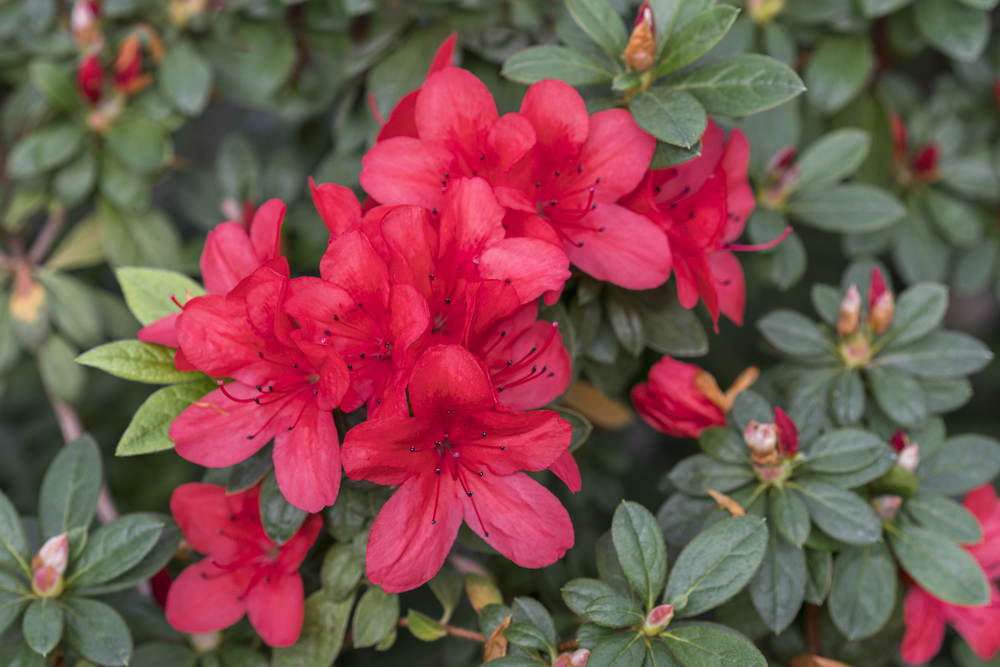Rhododendron indicum
Common Name:
Satsuki Azalea

General Information:
The azalea is a member of the genus Rhododendron. It is an evergreen which in the wild grows as a small shrub (up to six feet). There are hundreds of azalea cultivars. The azalea used to be considered a separate genus from the rhododendron, but has recently been reclassified.
The cultivar that is most commonly used for bonsai is probably the Satsuki azalea. The most interesting feature of the Satsuki azalea is that it produces flowers in multiple colours on the same plant. The flowers can be white, pink or red, and can grow singly or in pairs. Satsuki azalea originated in Japan and are more dwarf than other hybrid groups. Satsuki means “fifth month” and these hybrids are late bloomers.
Lighting:
Filtered, partial sun. Avoid prolonged direct exposure to spring and summer sun.
Temperature:
Protect the tree (preferably under glass) in the winter, but do not bring indoors.
Watering:
Keep the soil damp, as the roots can dry out easily and this is fatal to the tree. Water with rain water if possible. If using tap water that is high in lime, repot the tree every year to keep the soil acidity high.
Feeding:
Feed every 20-30 days with a slow-acting organic fertilizer, from early spring to late autumn, and apply chelated iron a couple times a year. Micro nutrients should be applied routinely.
If you prefer to use chemical fertilizers, feed every two weeks using a half- strength solution of a fertilizer for acid-loving plants, such as Miracid.
If the tree is repotted in spring, do not feed until autumn. Do not feed during the hottest month of the summer.
Pruning and wiring:
Prune branches and new shoots in late summer, using a sealing compound to seal wounds. Azalea can and will grow shoots from old wood. New shoots at the ends of branches grow in groups of five. These shoots should be reduced to two and the remaining shoots shortened to two sets of leaves. Wiring may be done from spring through summer. Use care when bending branches, as older branches are brittle. Skipping watering the day before wiring will make the branches more flexible. You may need to protect the bark by wrapping the wire with raffia.
Propagation:
Usually by cuttings to maintain hybrid characteristics. Take 3 to 4 inch cuttings after spring growth has hardened.
Repotting:
Repot in the spring after the flowers have gone by, every year for young trees, every 2-3 years for older trees. Azaleas like well drained, organic soils with a pH of 4.5 to 5.5. Some growers use pure peat moss, though this is probably too extreme. Using a soil mixture specifically intended for azaleas is advisable. Azaleas grow extremely dense, hairy root masses. Experienced growers of azalea bonsai recommend using a soil mix that contains no small particles at all, because of the dense growth of azalea roots. If soil with fine particles is used, the roots can form mats that shed water, making successful feeding and watering difficult. When repotting, trim the root ball and cut out pie-shaped wedges around the outside of the root ball so that the roots can grow into the gaps.
Pests and diseases:
Aphids, lacebugs, white fly, leafminers, spider mites, scale, stem borers. Diseases include petal blight, leaf gall, mushroom root rot.
Compiled by Sabrina Caine and Thomas L. Zane
